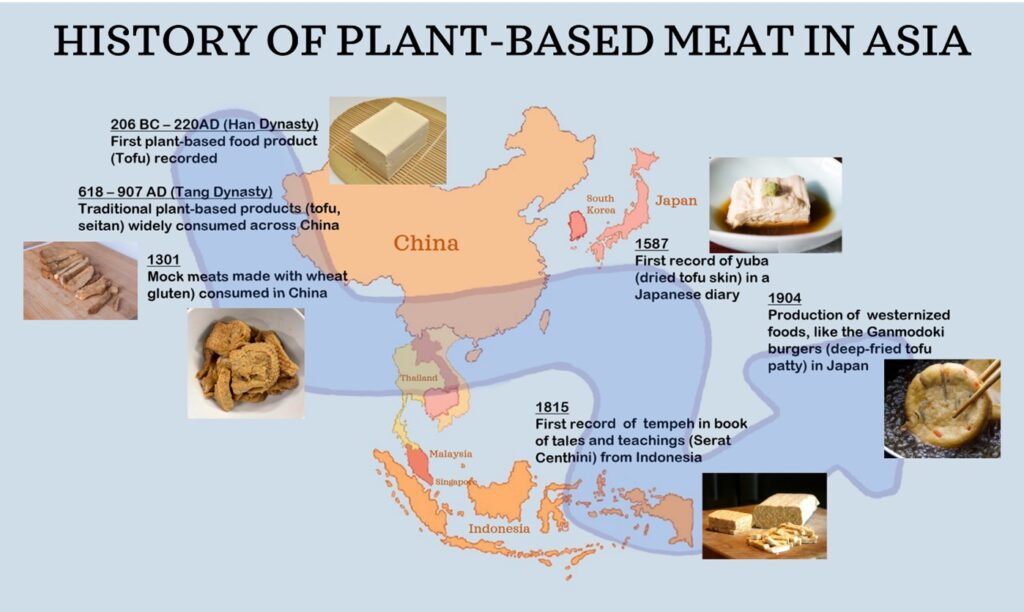Plant-based meat is actually centuries old!
Plant-based meat alternatives have been a hot topic for the last few years and are still associated with novelty. But did you know that the first record of a plant-based meat alternative was over 2000 years ago? Plant-based meat has a long and rich history in Asia and has been ingrained in various Eastern cultures since it was first consumed in ancient China.
One of the reasons plant-based meat alternatives were widely consumed in China was due to Buddhism. Buddhism prohibits the killing of any person or animal, leading Buddhists to adopt vegetarian diets. As part of their tradition, Buddhists incorporated “First-generation” plant-based meat alternatives – tofu, tempeh, and seitan – into their vegetarian diet.

Tofu – the first reported plant-based product
While it is difficult to pinpoint when the first plant-based product was made, tofu (coagulated soy milk) was the first reported product and was created in China during the Han Dynasty (206 BC-220 AD) over 20 centuries ago. Tofu was extensively consumed throughout various ancient Chinese Dynasties (Tang, Song etc.). Tempeh (fermented soybean), a traditional Indonesian staple, has been consumed in Southeast Asia for the past four to five centuries or longer!
Emergence of “Second-Generation” Plant-based Meat Products
In the 1300s, innovation in plant-based meat alternatives that were not merely traditional tofu or tempeh began to appear. Products like mock eel meat and mock sausage were developed in China. These are coined “Second-generation” plant-based meat alternatives. By the 1800s, such products were widespread in various Asian countries like Japan, Indonesia, and China.

In the early 20th century, food technology and food processing methods continuously improved. Fried textured vegetable protein (TVP) (a mixture of soy protein and wheat gluten) further enhanced the taste and texture of plant-based meat products. More westernised food products were also being developed in Asia, such as Ganmodoki, a deep-fried tofu patty burger originating from Japan. Although “Second-generation” plant-based meat alternatives originated from Buddhist temples, they were not eaten on a day-to-day basis as they were considered too extravagant.
Musings From the Temple: Quotes by Monks on Plant-based Meat

Fast Forward to 2023: What’s Trending in Asia Now?
Plant-based meat alternatives have come a long way since their creation thousands of years ago. In Asia, constant innovation, and advancement of technology in the plant-based industry has birthed a new era of plant-based meat products.
Spoilt for Choice: The Rise of Asian Plant-based Meat Manufacturers

A rising number of plant-based meat manufacturers and start-ups have been established in Asia. The Asian plant-based food market has been estimated to be worth 17,473 million USD and is expected to grow by about 10% in the next few years. Several brands do not only make the usual plant-based burger patties and nuggets but have products that specifically cater to the Asian palate. For example, OmniMeat offers various Asian-inspired plant-based products such as luncheon meat, gyoza and shrimp dumplings. On the other hand, Unlimeat has released plant-based mandu (Korean meat dumpling), and vegetarian Korean-marinated barbeque meat alternatives.
Looking Into the Future: Importance of the Asian Plant-based Market
Although Asians consume the most amount of meat worldwide, traditional plant-based meat alternatives have been an integral part of Asian’s diets for many centuries, so it should be relatively easy for Asian consumers to welcome and include novel plant-based meat products into their diets compared to western society.
Perhaps we need to look at what drives the continual consumption of traditional plant-based meat products; what has kept them a constant component in the Eastern diet for so many centuries? These findings could be helpful to aid plant-based meat alternative manufacturers to develop novel plant-based meat products that have the desirable taste and texture of their traditional counterparts, so that consumers can discover some familiarity in these novel products.
Xanthe Lin and Amanda Lim, 2 May 2023
